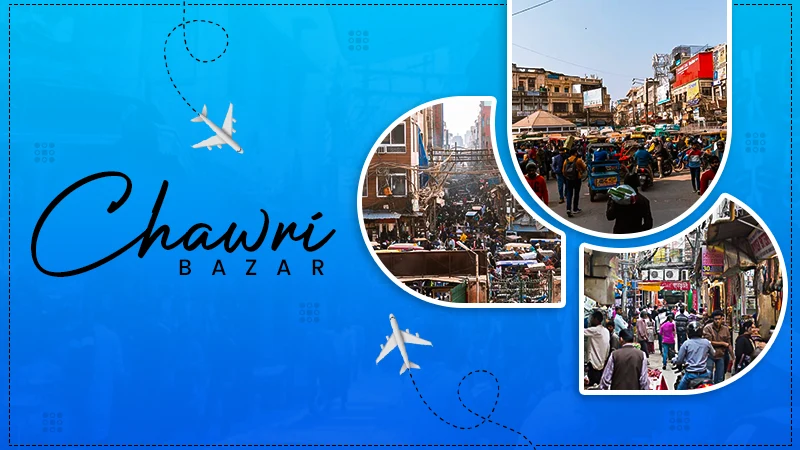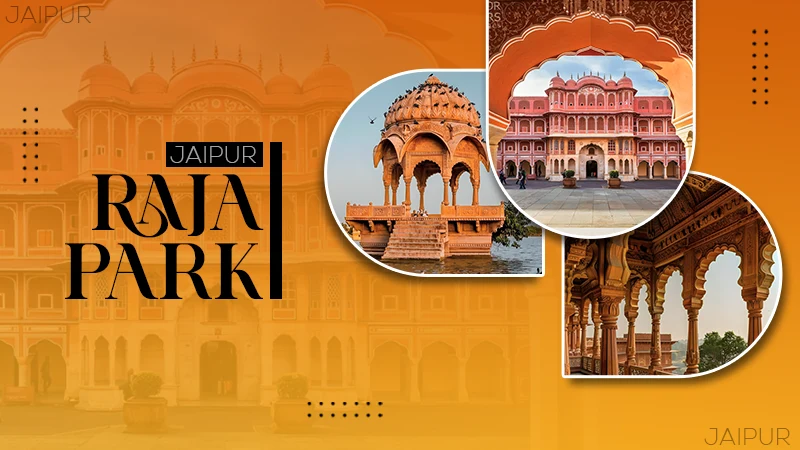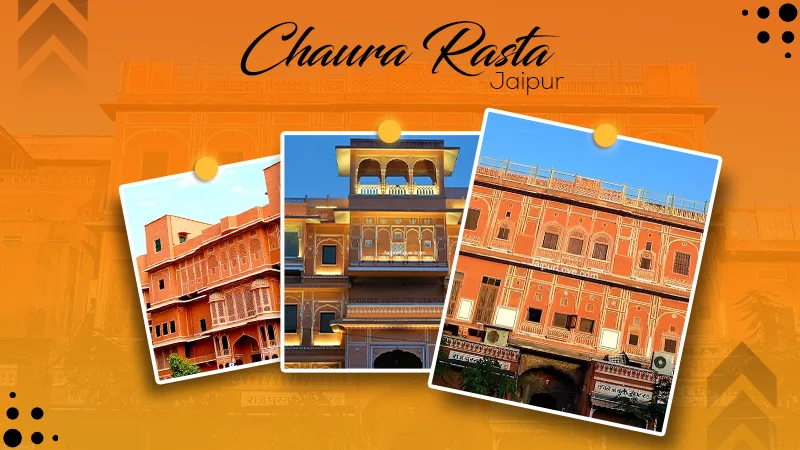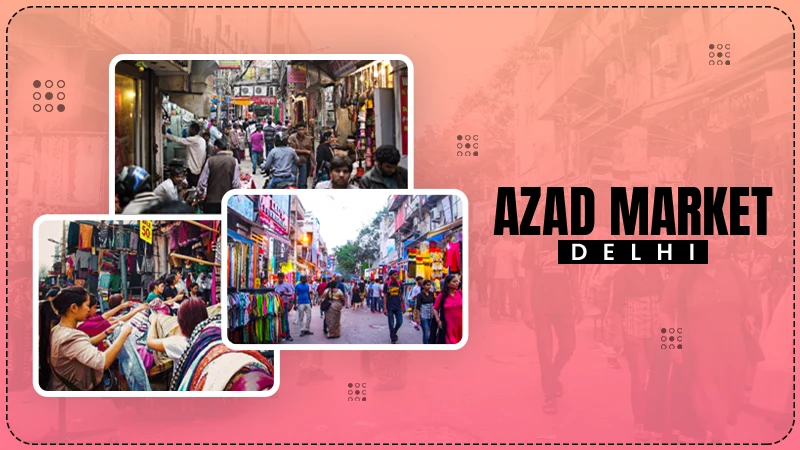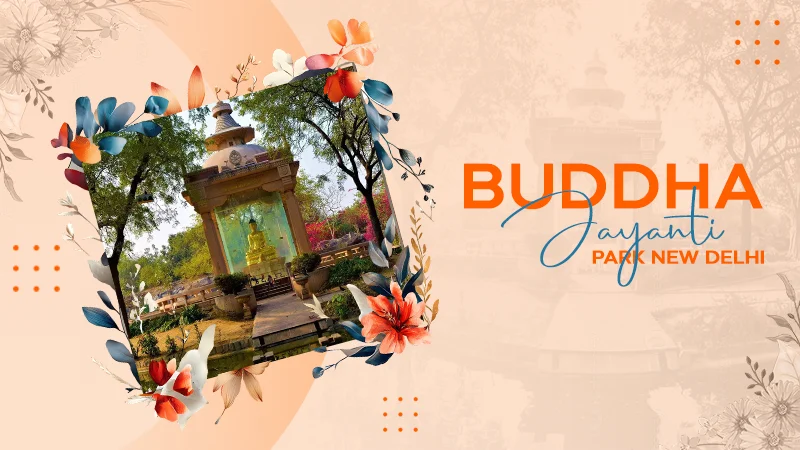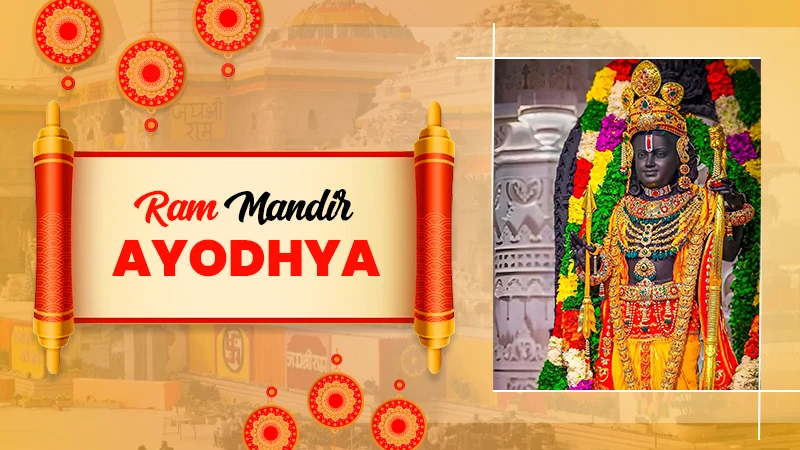
- Ram Mandir Ayodhya History: Decades-Old Promise Fulfilled
- Ram Mandir Ayodhya Inauguration Date
- Ram Mandir Ayodhya Location
- How to Reach Ram Mandir in Ayodhya
- Ram Mandir Ayodhya Construction and Architecture
- Ram Mandir Photos
- Key Features and Facilities of Ram Mandir Ayodhya
- Places to Visit Near Ayodhya Ram Mandir
- Conclusion
The whole world witnessed Diwali on the 22nd of January when finally centuries-old feuds came to a halt and the Ram Mandir was inaugurated in Ayodhya, dedicated to Lord Ram.
Ever since 1858, this temple has been the center of political and religious disputes in India. So if you’re traveling to Uttar Pradesh, Ram Mandir is a must visit, along with Kashi Vishwanath, which is famous as one of the 12 Jyotirlingas.
In this article, we will provide all the information regarding the Ram Mandir temple, including its construction, architecture, inauguration, key features, and importance.
Here are some quick information about Ram Mandir:
| Total Area | 2.7 Acres |
| Total Built-up Area | 57,400 Sq. ft. |
| Total length of the temple | 360 ft |
| Total width of the temple | 235 feet |
| The total height of the temple including the peak | 161 feet |
| Total number of floors | 3 |
| Height of each floor | 20 feets |
| Number of columns on the ground floor of the temple | 160 |
| Number of columns on the first floor of the temple | 132 |
| Number of columns on the second floor of the temple | 74 |
| Number of pedks and pavilions in the temple | 5 |
| Number of Gates in the temple | 12 |
| Ram Mandir budget | ₹1800 Crore |
Ram Mandir Ayodhya History: Decades-Old Promise Fulfilled
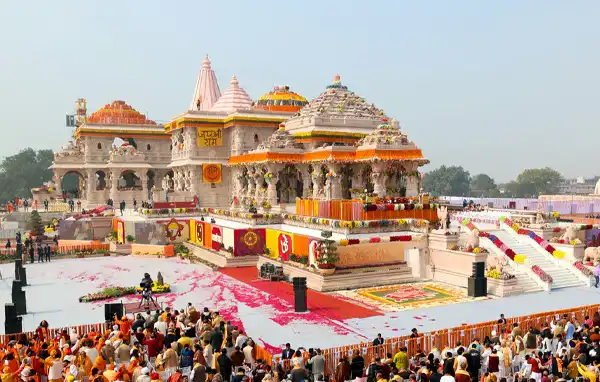
Where it all started
The feud over Ram Janmabhoomi is much older than the riots of 1992; it goes back to the 16th century, when the temple of Lord Ram was destroyed by Babur’s general Mir Baqi, and a Mosque was built instead. This mosque was known as Babri Masjid.
The first Religious Violence
The demolition of Ram Mandir infuriated the Hindu devotees and the first religious violence took place in 1853. Six years later, the British fenced and divided the site so that both Hindus and Muslims could pray there. It was, however, still not equal, as the Ram Chabutra was laid under the open sky without a canopy, but the feud continued, and the Masjid was shut down.
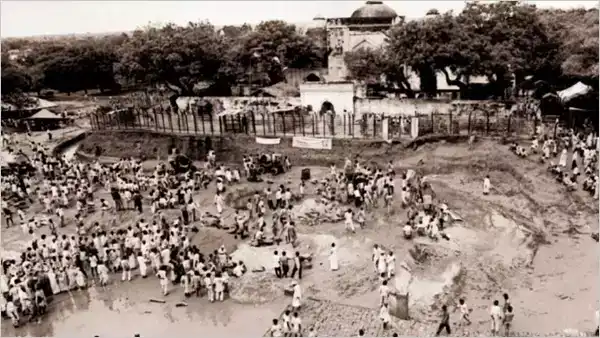
After too many petitions and pleas, the Ayodhya court ordered the Mosque in 1986 to be opened for Hindus to offer prayers, before which only the priest was allowed to conduct the annual puja.
The Demolition of Babri Masjid
After a couple of other events, on December 6, 1992, the disputed Babri Masjid was demolished by karsevaks under the presence of Shiv Sena, the VHP, and the BJP. This triggered widespread protests across the country, like the Gujarat riots of 2002, which in total claimed more than 3000 lives.
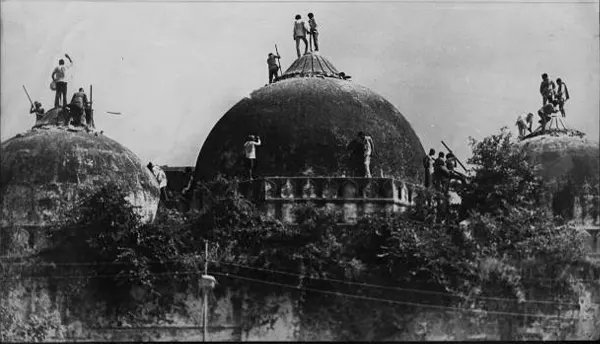
In 2010, the High Court divided the land into three parts: One for Hindu Mahasabha, one for Islamic Waqf Board, and the last one for Nirmohi Akhara. But no side was satisfied by this decision of the high court.
Verdict in favor of Ram Mandir
Finally, on November 9, 2019, a five-judge bench of the Supreme Court issued a verdict asking the government to hand over the land for Ram Mandir Ayodhya construction. Additionally, the court also asked the government to allocate an alternative five acres of land at a different location for the construction of the mosque.
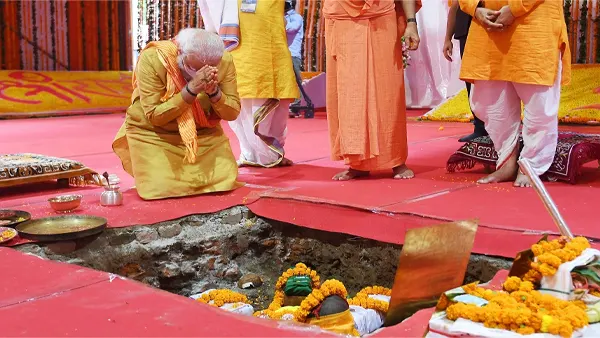
Bhoomi Poojan and consecration ceremony of Ram Mandir
On August 5, 2020, Prime Minister Narendra Modi Laid the foundation stone for the construction of the Ram Temple, and finally, on January 22, 2024, the Temple was inaugurated on a large scale with a beautiful idol of Ram Lalla.
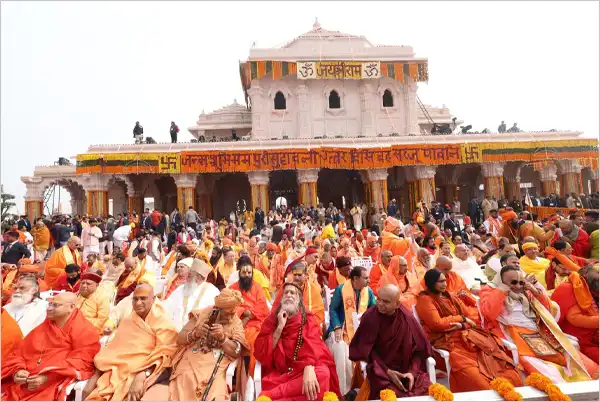
Ram Mandir Ayodhya Inauguration Date
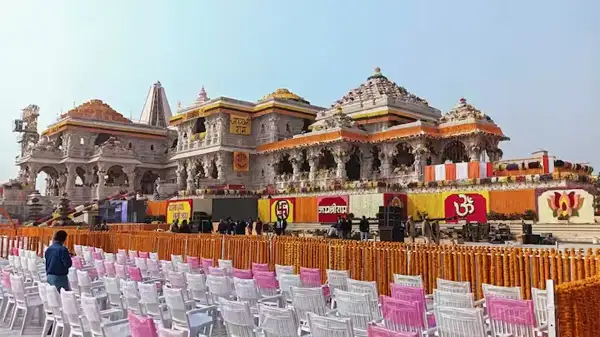
After hundreds of petitions and 500 years of struggle, the Ram Mandir inauguration date finally arrived. 22nd January 2024 marked the Ram Mandir opening date for the consecration ceremony and for the general public to offer prayers to Lord Ram.
The ‘pran pratishtha’ ceremony carried out by PM Narendra Modi addressed a gathering of around 8000 VVIPs including Bollywood celebs and many millionaires. The ceremony was broadcast live all around the world and on several YouTube channels.
Ram Mandir Ayodhya location where the inauguration took place, is also of great importance as it’s the birthplace of Lost Ram, also known as the Ram Janmabhoomi.
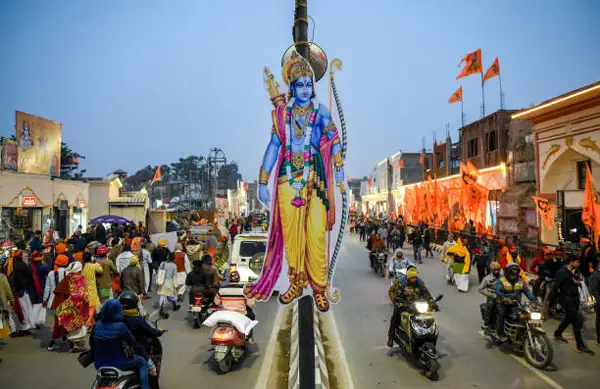
Ram Mandir Ayodhya Location
If you too are dying to visit the majestic temple but you still don’t know where is Ram Mandir exactly located, keep reading!
The temple is located in the Ram Janmabhoomi which translates to the birthplace of Ram in Sai Nagar, Ayodhya, Uttar Pradesh. The Ram Mandir area is around 70 acres in total.
Here is the exact Ram Mandir, Ayodhya location:
How to Reach Ram Mandir in Ayodhya
After the construction of Ram Mandir, special attention was paid to all the modes of transport, like railways and airports for a buzz-free commute for devotees. Maharishi Valmiki International Airport, Ayodhya Dham was also constructed in February 2022 and opened in December 2023.
Since the airport became operational, reaching Ayodhya has become easier than ever! If you don’t know where is Ram Mandir situated, here’s how you can reach the temple:
By Air
- Maharishi Valmiki International Airport Ayodhya Dham (17 km away)
- Gorakhpur Airport (139 km away)
- Chaudhary Charan Singh International Airport, Lucknow (156 km away)
By Train
- Ayodhya Junction (2.5 km)
- Gorakhpur Junction (113 km)
- Lucknow Junction (144 km)
By Road
Ayodhya is well-connected by road and public transport to all the major cities of India. Uttar Pradesh Transport Corporation and private buses, and taxis are available at Ram Mandir station.
After reaching Ayodhya you can take a bus or taxi to reach Ram Mandir. There are several hotels and Dharamshala available for devotees to stay.
Ram Mandir Ayodhya Construction and Architecture
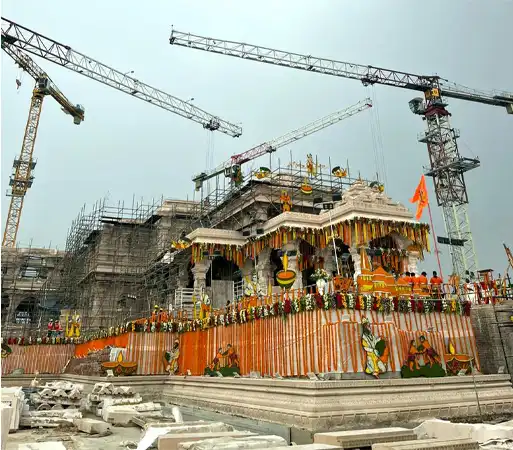
The Ram Mandir Ayodhya construction started in August 2020 after ‘Bhumi Pujan’ by the PM of India. A trust was formed to oversee the construction of the temple, called the Shri Ram Janmabhoomi Teerth Kshetra Trust which began the first phase of construction.
The whole temple is constructed with 17,000 m3 of Red Sandstone from Baansi in Rajasthan. The construction material included both marble and sandstone, with no use of steel or iron to increase the durability of the structure.
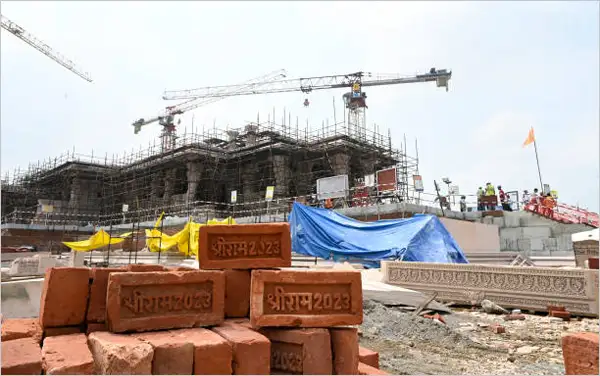
The architecture of Ram Mandir
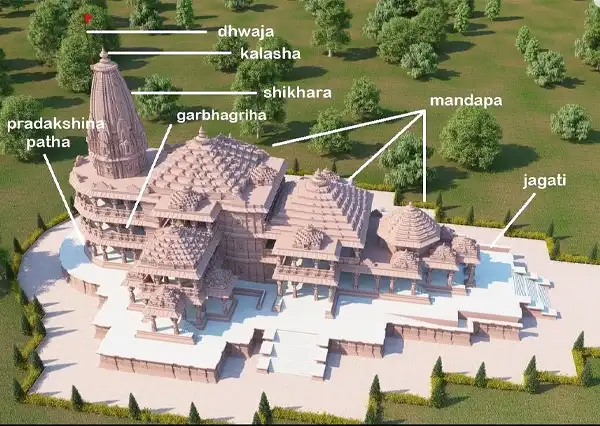
Ayodhya Ram Mandir’s architecture is a symbol of spiritualism and grandeur. This grand temple is constructed with both traditional and contemporary architecture to give it a deep, debonair look.
The old as well as the new design of the Mandir were devised by the Sompura family. Here are some key elements of the architecture of Ram Mandir.
- Grand Nagara style — The Temple is built in the Grand Nagara style, which is a popular temple architecture in northern India characterized by towering spires, intricate carvings, symbolic representations, stone platforms, Garbhagriha, etc. One of the most popular examples of the grand Nagara style is the Konark Sun Temple.
- The Grand Shikharas — Garbhagirha which is the womb chamber—is crowned by a structure called a shikhara, which is adorned by many intricate carvings and structures.
- Dimensions and Ram mandir area in acres — The temple covers 2.77 acres and the entire complex is spread over 70 acres of land. The Ram Mandir structure is 380 ft (115.82 m) long, 250 ft (76.2 meters) wide, and 161 ft (49.07 meters) high. The whole complex can accommodate around a thousand devotees at any time. The ram mandir structure is three storeys high and is built on a raised platform.
- Columns containing other idols — There are a total of 366 columns containing 16 idols each, including the incarnation of Lord Shiva, the 10 Dashavataras, the Chausath Yoginis, and the 12 incarnations of the goddess Saraswati.
- Vastu Shastra — The temple adheres to the principles of Vastu Shastra and Shilpa Shastra, which are the traditional Hindu systems of architecture that describe the principles of design, layout, measurements, etc. to harmonize the temple’s energy.
- Prayer halls and lecture halls — The temple also has space for prayer halls, lecture halls, educational, museum, and other spaces where devotees can participate in religious ceremonies.
- Gardens — The temple is strategically built and has beautiful surrounding gardens to make the overall place look more serene and calm. Three levels of tree plantation are undertaken to protect the temple and premises from seasonal dust and storms.
Other Holy Places in the Temple
The temple is constructed with several holy places and facilities; here are a few of them:
- Shri Ram Kund – Home of holy offerings
- Karm Kshetra – House of holy rituals
- Hanuman Gadhi (Gigantic statue of lord Hanuman)
- Shri Ramlala Purakalik Darshan (For the display of archaeological & historical relics related to Ram’s Birth Place)
- Shri Kamm Keerti (House for discourse and mass prayer)
- Guru Vashishtha Peethika (Center of study for research on Ved, Puran, Ramayan & Sanskrit)
- Bhakti Teela (Special peace zone for deeper meditation)
- Tulsi (Ramlila Center, 360 degrees Theather/Open Air Theater)
- Ram Darbaar (Multifunctional/Projection/Lecture & Communication Center)
- Mata Kaushalya Vatsalya Mandap (Exhibition hall, Tableau complex)
- Ramangan (Exclusive Cinema/Television/AV Based Show & Discourse Theater)
- Ramayan (Modern A/C library and Reading Room)
- Maharshi Valmiki (Archives and Research Center)
- Ramashrayam (Multistories boarding, lodging facility & waiting lounge for outstation devotees)
- Shri Dashrath (Shelter for Cows)
- Laxman Vatika (Lily-pond and Musical fountains)
- Lav Kush Nikunj (Activities Area for Youth and Children)
- Maryada Khand (Special guests residential Area cottages and Multistory Apartments enclave)
- Bharat Prasaad-Mandap (Canopy Courts for Naivedya/Prasaad/Bhog)
- Mata Sita Rasoi Annakshetra (Large food shelter for mass feeding)
- Singhdwar Ke Sammukh Deepstambh (Lamp tower in front of the Lion Gate Portal).
Larsen & Toubro offered to oversee the design and construction of the temple free of charge, and IIT branches in Bombay, Guwahati, and Madras have also assisted in the soil testing, concrete supply, and design. The Ram Mandir in Ayodhya is the largest Hindu temple in the world.
Ram Mandir Photos
Here are some photos of Ram Mandir from the outside and inside:
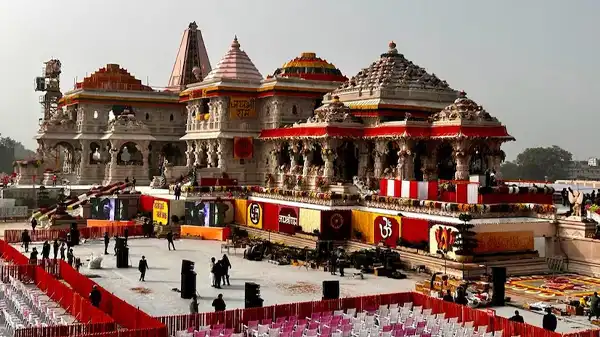
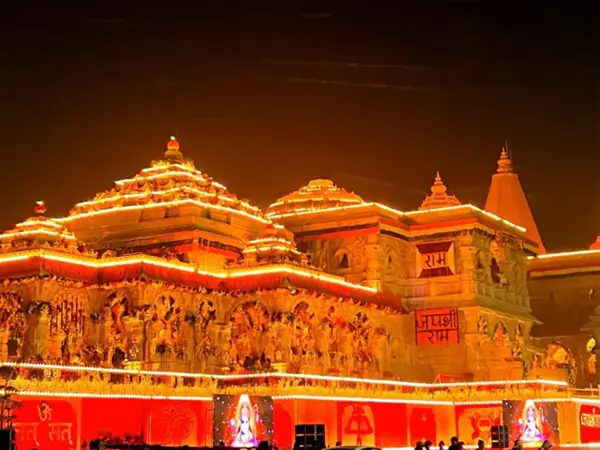
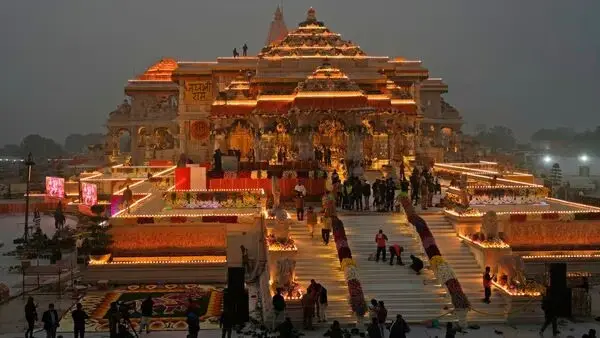
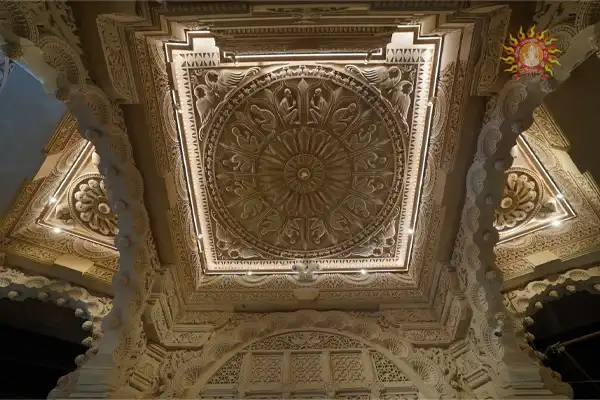
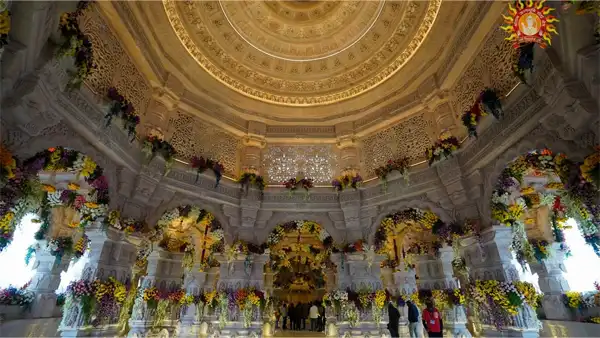
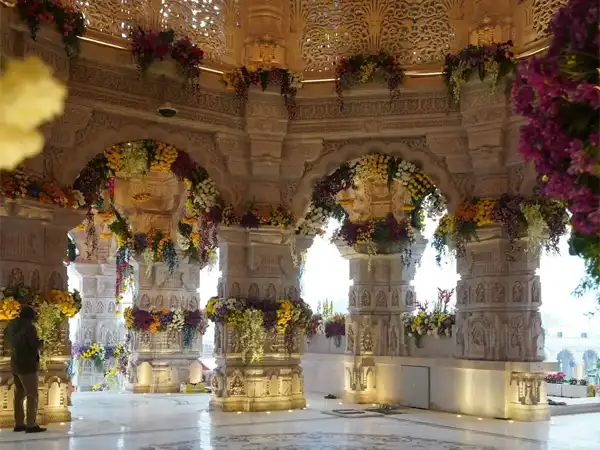
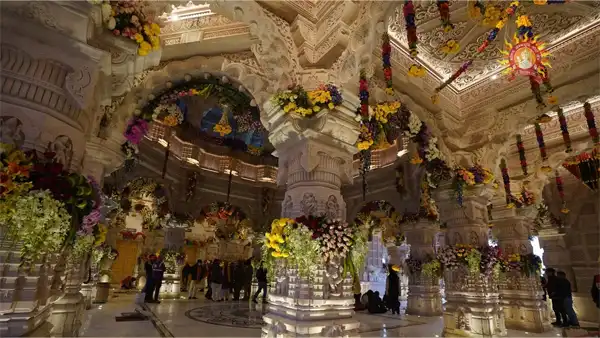
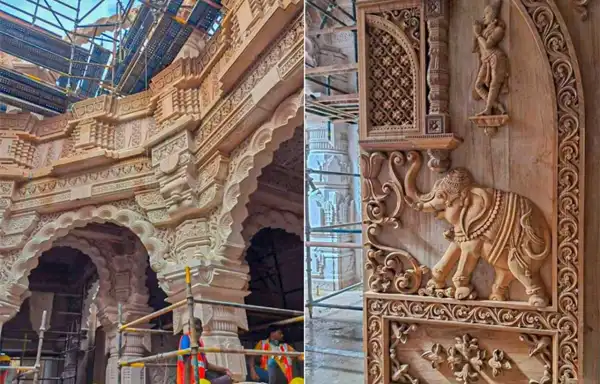
To see more of Ram Mandir, watch this YouTube vlog by Jatt Prabhjot:
Key Features and Facilities of Ram Mandir Ayodhya
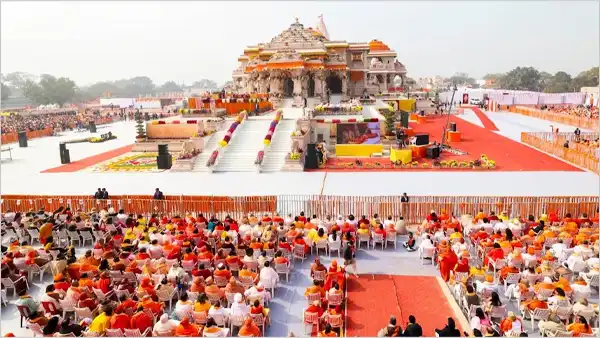
The more I write about this majestic temple, the less it seems. There are so many big and small features and specialties in the Ram Mandir that you should know if you’re planning a visit to Ayodhya.
- Solar panels are installed to save energy and increase the use of green electricity in the Temple.
- Mata Sita Rasoi is a food shelter that offers pure vegetarian food to all the devotees visiting the temple. The shelter has a kitchen, large storage, systematic cutlery, utensil storage, and a handwashing facility.
- A grand bell made out of Ashtadhatu (a mixture of eight metals), weighing 2100 kg, was prepared over 2 years by the local artisan of Uttar Pradesh for the mandir.
- Janakpur in Nepal, which is also known as the birthplace of the goddess Sita sent over 300 gifts for the inauguration of Ram Mandir. The gifts included gold and silver shoes, ornaments, and clothes and were transported to Ayodhya by more than 30 vehicles.
- A time capsule is placed 2000 feet (0.61 km) below the temple, containing all the facts about the Janmabhoomi.
- The bricks used in the Ram Mandir Ayodhya construction had ‘Shri Ram 2023’ written on them to commemorate the year of the temple’s construction.
- The temple trust launched a “mass contact and contribution campaign” and as of October 2023, domestic voluntary donations across India reached a total of ₹3500 crore.
- After its complete construction, Ram Mandir became the world’s largest Hindu temple.
- The idol of Ram Lalla Virajman, the infant form of Lord Ram was made out of 2 Shaligram rocks which are 60 million years old, weighing around 26 tonnes and 14 tonnes.
- There are other facilities in the temple too like ATM/Bank, ramps for devotees, emergency medical aid, a pilgrim facility center, an administrative office, and a Pilgrim/visitor management system.
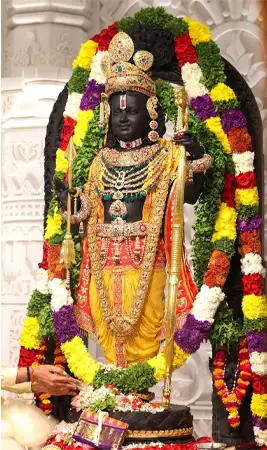
Fun Fact — The face of Ram Lalla’s Idol has considerably CHANGED after the ‘pran pratishtha’ ceremony. The statue now almost looks like it’s alive.
Places to Visit Near Ayodhya Ram Mandir
If you are thinking of visiting Ram Mandir Ayodhya, there are a few places you should definitely include in your itinerary.
- Hanuman Garhi Mandir — A famous Hindu temple of the Lord Hanuman build on the bank of Saryu River around 300 years ago.
- Kanak Bhawan — Kanak Bhawan id another famous temple in Ayodhya and is said to be a private chamber of the Lord Ram and Goddess Sita
- Mathura and Vrindavan — These twin sites are of great importance in Hindu culture. Mathura is the birthplace of Lord Krishna while Vrindavan is where he spend his childhood.
- Mani Parvat — This is a 65-foot-tall mountain in Ayodhya and is considered to be a part of the Sanjeevani Booti hill.
- Vidya Kund — This is said to be the place where Lord Ram and his brothers received their education.
Conclusion
After the construction of Ram Mandir and the beautification of Ayodhya, it has become one of the best places to visit in September in India. The construction of the Ram Janmabhoomi temple has made history, ending a 500-year-long religious feud. Ayodhya welcomed not just the Ram Mandir temple but many other attractions.
So what are you waiting for? If you too are looking to witness the majestic beauty of this holy temple, plan a trip to Ayodhya today!
Ram Janmabhoomi Mandir is in which city?
The newly inaugurated Ram Janmabhoomi Mandir is opened in Ayodhya.
What is the height of Ram Idol in Ayodhya?
The Ram Idol which is installed in the Ram Mandir Ayodhya is 181 meters (594 ft) tall and 251 meters including the pillars and canopy.
Who made the idol of Ram?
The idol of lord Ram was made by Arun Yogiraj who has made many iconic statues before.





